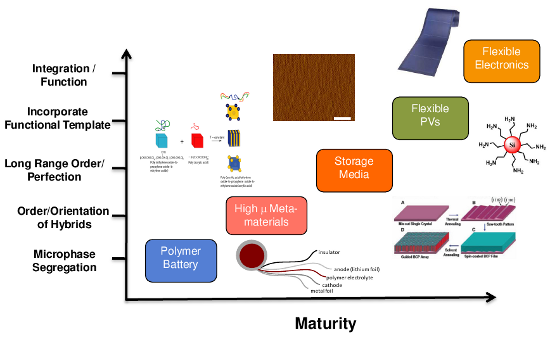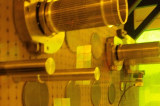- Home
- Research
- Education & Outreach
- Facilities
- Industry
Test Bed 3: Roll-to-Roll Nanoscale Processing
Co-Leaders
Jonathan Rothstein (Mechanical and Industrial Engineering) and Kenneth Carter (Polymer Science and Engineering)
Participating Faculty
Brian Anthony (MIT), Duane Boning (MIT), Alfred Crosby (PS&E), L. Jay Guo (University of Michigan), David Hardt (MIT), Matteo Pasquali (Rice University), Thomas Russell (PS&E), and James Watkins (PS&E)
Roll-to-Roll Process Development Facility
The focus of the CHM system-level test beds has shifted from an emphasis on the development of processes for silicon wafer platforms to the development of a manufacturing platform for fabrication of low-cost, large-area nano-materials and devices using roll-to-roll processing technology. In a previous test bed entitled "Self-Assembled Polymer Templates for Device Applications", the viability of self-assembly of block copolymers (BCP) for use in patterning ultra-high density magnetic storage media was demonstrated. Many of the key challenges were addressed and commercialization efforts are under way to implement this technology. The test bed efforts combined with the synergistic scientific advances developed within TRG 1 played a significant role in identifying and resolving many key challenges and enabling technology transfer. The roll-to-roll test bed follows the same successful, collaborative development model as the CHM's previous test beds. Our plans for developing the roll-to-roll platform are framed in large measure by the challenge of fabricating nanostructured thin films on a high-speed, high-reliability platform. This task must be accomplished with relatively low complexity with an inexpensive materials set that will enable its use for low-cost, high volume commercial applications including water purification and filtration, batteries, and thin film organic-based photovoltaics.
Development of the Roll-to-Roll Coating and R2RNIL Tool
Given the promise of success based on recent developments of prior center research (TRG 1 and the BCP test bed), the CHM has developed a facility for the fabrication of materials and devices via self-assembly and nanoimprint lithography (NIL) on a roll-to-roll platform. The facility is housed in a soft-wall clean room in the Conte Research Center and contains coating equipment, a roll-to-roll NIL tool, an AFM, a profilometer and other analytical tools. A micro gravure coater has also been installed with a second R2R coater to be installed in spring 2012.

Figure 1 Schematic of product platforms for the phased development of the CHM test bed in roll-to-roll processing of self-assembled materials and devices.
Self-assembled BCPs present ideal scaffolds and templates for nanofabrication. When one considers the complexity, cost, and size limitations of current top-down methods, BCPs are extremely attractive. Accordingly, BCPs are an obvious first system to implement in the roll-to-roll facility because the underlying technologies are already relatively mature. One key breakthrough has been the identification of an adequate source of inexpensive BCPs. Prof. Watkins has developed (TRG1) several novel approaches to obtain order in inexpensive Pluronics® BCPs. He and Prof. Carter have shown that on PET substrates, the Pluronics® micro phase segregate into cylindrical domains oriented normal to the substrate.
As illustrated in Figure 1, the CHM has targeted product platforms that both take advantage of and demonstrate the unique technical capabilities of the roll-to-roll test bed. They are arranged in terms of complexity and represent both near term targets that require modest amounts of additional development to applications that will require the entire technical capabilities of the fully developed test bed platform. As the R2R technology matures, more complex applications will be investigated. The first product targeted by the test bed platform is the development of microphase segregated solid polymer electrolytes (SPE) for lithium ion batteries. We are currently fabricating layers with excellent lithium ion mobility using additive-induced assembly of otherwise disordered surfactant blends. If this technology is to be ported from planar wafers to a polymer web, the effect of particle loading and fluid rheology on the final coating thickness, uniformity and homogeneity of the polymer and particles dispersion, and particle alignment must be understood as a function of parameters like web speed, tool design, solvent evaporation rate and fluid rheology. Rheological characterizations and experimental measurements will both motivate and be motivated by numerical simulations in collaboration with reserachers from Rice University.
The development of a roll-to-roll NIL (R2RNIL) tool has formed an essential part of the test bed that will allow us to move along the direction of increased complexity shown in Figure 1. Russell has shown the micro phase segregation of BCP on top of PET films imprinted with a miscut sapphire wafer can produce long-range crystalline ordering domains over several centimeters. Similar results were obtained by annealing the BCP on the same surface texture replicated in a highly cross-linked silicone. Using R2RNIL to replicate the miscut sapphire surface texture on a continuous film would facilitate the development of flexible ordered media for data storage for which near perfect ordering of the phase segregated BCP is required. The CHM R2R Nanoimprint tool is shown in Figure 2. The tool was constructed on a stiff aluminum test stand fabricated from 80/20 modular framing making the design flexible to future design modifications.

Figure 2 Roll-to-roll nanoimprint lithography tool.
Metrology for Manufacturing and Control
The objective of roll-to-roll nanoimprint manufacturing is to precisely pattern nano-structures over square meters of areas. Real-time, in-line measurements of the film on both of these length scales are therefore necessary for statistical process monitoring and feedback control. Possible non-contact optical techniques to do so at the nanometer scale are being investigated in collaboration with investigators from MIT and NIST. When combined with models of the expected patterns, these techniques may be used to generate a real-time continuous topographic map showing variation of film thickness, in-plain deformation, and measures related to the fidelity of the nanoscale pattern.













